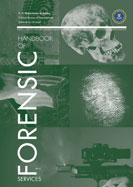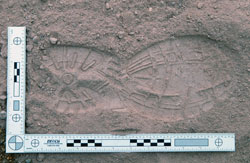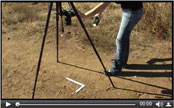Are you having trouble viewing this email? View it online here: www.crime-scene-investigator.net/newsletter/1014.html This message
was not sent unsolicited. You signed up for this newsletter. If you wish to unsubscribe see the instructions at the bottom of this message.
|
|
||
|
OCTOBER 2014 | ||
|
Welcome to the October 2014 Crime Scene Investigator Network Newsletter
| ||
|
This Month's Featured Resource on the Crime Scene Investigator Network Website
|
||
 Handbook of Forensic Services
Federal Bureau of Investigation The Handbook of Forensic Services provides guidance and procedures for safe and efficient methods of collecting, preserving, packaging, and shipping evidence and describes the forensic examinations performed by the FBI's Laboratory Division and Operational Technology Division. The successful investigation and prosecution of crimes require, in most cases, the collection, preservation, and forensic analysis of evidence. Forensic analysis of evidence is often crucial to determinations of guilt or innocence. <View the Publication> |
||
|
Featured Video Presentation
|
||
|
Learn the basic technique for photographing footwear impressions. |
||
|
New CSI and Forensic Job Announcements
|
||
|
The most comprehensive listing of Crime Scene Investigation and Forensic To be notified of job openings as they are posted, follow us on Twitter: Job Posting Alerts |
||
|
Crime Scene Investigator
Orange County Sheriff, Florida, USA Final Filing Date: Open until filled Salary: $33,737 or $35,443 annually with 3+ years experience Applies scientific principles to analyze, identify and classify physical evidence related to crime scenes by performing the following duties: Searches for, collects, photographs, and preserves evidence. Analyzes items such as paint, glass, printed matter, paper, ink, fabric, dust, dirt, gases, or other substances. Identifies hair, skin, tissue, blood, bones, or human organs. Performs a variety of analytical examinations. Processes the crime scene using chemicals, light source enhancement, and other methods. Reconstructs crime scene, preserving marks or impressions made by shoes, MORE <View complete job listing> |
||
|
Analyst — Computer Forensics
Las Vegas Metro Police Dept, Nevada, USA Final Filing Date: December 12, 2014 Salary: $5,839.58 - $8,314.73 Monthly Incumbents perform analytical work in the LVMPD's computer forensics lab. This analytical work is in support of programs and projects of the LVMPD. Incumbents also perform in-depth criminal investigation which require the use of computer forensics; and provide information and assistance to the public and others regarding assigned investigations. <View complete job listing> |
||
|
Forensic Scientist — DNA
Austin Police Department, Texas, USA Final Filing Date: October 15, 2014 Salary: $22.76 - $28.93 per hour Analyzes evidence for detection of body fluids. Performs DNA testing on biological evidence. Interprets DNA test results and prepares detailed analysis reports. Creates and maintains records and/or documents. Assists in the maintenance of laboratory instruments and reagent preparation. Testifies as an expert witness in court. Trains police personnel in evidence collection and preservation of DNA. Performs proficiency testing by correctly processing samples. Performs technical and administrative reviews of other DNA Scientist's casework. Participates in ongoing education in accordance with Federal Bureau of Investigation guidelines and requirements. <View complete job listing> |
||
 |
||
|
Property Controller II
California Department of Justice, Riverside, USA Final Filing Date: October 22, 2014 Salary: $3,363.00 - $4,208.00 per month Performs a variety of evidence, property control and other related duties for the Bureau of Forensic Services, Riverside Laboratory. Receives and records controlled substances, blood alcohol, firearms, biological and other types of evidence from law enforcement agencies in person, via US mail, and/or other private couriers. Ensures that a proper chain of custody is maintained as well as maintains and organizes the evidence vault. Ensures that submittals conform to established laboratory and bureau policies relative to packaging, chain of custody and completion of MORE <View complete job listing> |
||
|
Fingerprint Technician 2 in-training
Washington State Patrol, Olympia, USA Final Filing Date: October 26, 2014 Salary: $2,598.00 - $3,377.00 Monthly These positions will work in a training capacity, under close supervision, performing technical fingerprint identification and criminal records work consisting of classifying and comparing fingerprints of unknown persons and crime suspects according to acceptable methods. NOTE: These positions will be hired at the Fingerprint Technician 1 level, in-training to a Fingerprint Technician 2. The training plan will continue for 3 years. At the end of the 3 years, if the incumbent successfully completes all portions of the in-training plan, they will promote to the Fingerprint Technician 2 level. <View complete job listing> |
||
|
Hi-Tech Crime Investigator
British Transport Police, London, UK Final Filing Date: 23 October 2014 Salary: £30,101 - £34,058 per annum + £2470 London allowance Secure, retrieve and examine data from computer and digital media utilising proprietary and bespoke software to ensure forensically sounds results. Secure, retrieve and examine data from mobile phones, satelitte navigation systems and other similar devices utilising proprietary and bespoke software to ensure forensically sounds results. Process and examine the recovered data in accordance with best practice and produce the resulting information in a form which can be readily understood and evaluated. Produce comprehensive reports suitable for presentation in an evidential format at court thus assisting the criminal justice process. MORE <View complete job listing> |
||
|
Search for more job listings in Crime Scene Investigations and Forensics To be notified of job openings as they are posted, follow us on Twitter: Job Posting Alerts |
||
|
Other Resources on the Crime Scene Investigator Network Website
|
||
|
Not Subscribed to this Newsletter?
|
||
|
If you are not subscribed to this newsletter, you may subscribe with this link: SUBSCRIBE via email |
||
|
To Unsubscribe
|
||
|
To unsubscribe from future e-mail newsletters, please click here: UNSUBSCRIBE Copyright ©2014 Crime Scene Resources, Inc. Crime Scene Investigator Network |




